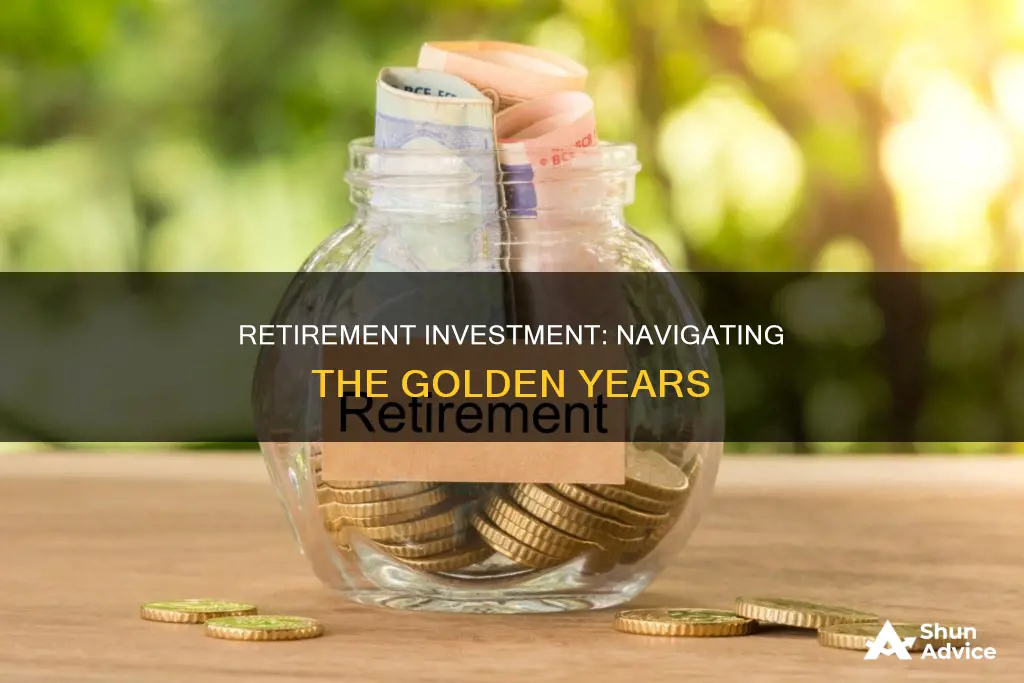
Retirement investments are an important part of planning for the future, especially as people are now expected to live for 30 years or more after retiring. There are many different types of retirement plans and investment options to choose from, each with its own benefits and drawbacks.
Some of the most common retirement plans include defined contribution plans such as 401(k)s, 403(b)s, and 457(b)s, as well as traditional pensions, annuities, and various types of IRAs. The best investment strategy for retirement will vary depending on individual circumstances, but it is generally recommended to maximise any employer contributions and take advantage of tax benefits where possible.
When it comes to the underlying investments within retirement plans, diversification is key to minimising risk and maximising returns. This can be achieved through mutual funds, index funds, ETFs, and individual stocks and bonds. The specific mix of investments will depend on factors such as risk tolerance, time horizon, and investment goals.
Overall, retirement planning and investment is a complex process that requires careful consideration of various factors. It is important to seek professional advice and tailor investment strategies to individual needs and circumstances.
| Characteristics | Values |
|---|---|
| Rate of return | 10% or less is considered conservative |
| Investment types | Exchange-traded funds (ETFs), Real Estate Investment Trusts (REITs), Certificates of deposit (CDs) |
| Risk tolerance | Younger investors tend to have more risk tolerance |
| Asset allocation | A mix of stocks, bonds, and cash investments |
| Investment management fees | Can impact the overall rate of return |
| Taxes | Can impact the overall rate of return |
| Inflation | Can impact the overall rate of return |
| Time horizon | Longer time horizon often means more risk within a portfolio |
| Diversification | Decreases overall investment risk and increases potential for overall return |
What You'll Learn

Annuities
There are several types of annuities:
- Fixed annuities promise a minimum interest rate and fixed periodic payments.
- Variable annuities allow you to direct payments to different investment options, usually mutual funds, and payouts will vary depending on these choices.
- Indexed annuities combine features of securities and insurance products, with returns based on a stock market index.
- Income annuities offer a payout for life or a set period in return for a lump-sum investment.
- Tax-deferred annuities allow you to accumulate savings without paying taxes until you withdraw the money.
- Deferred income annuities (DIAs) provide a fixed payout at a predetermined future date.
- Immediate fixed income annuities provide immediate income in exchange for a lump-sum investment.
- Joint and survivor annuities continue to pay a fixed amount to a second annuitant after the first annuitant's death.
The Great Debate: Paying Off Loans vs. Investing During Residency
You may want to see also

Bond funds
- Safety and Stability: Bond funds are considered safer than stocks because they are less volatile and provide a more stable income stream. This is especially important for retirees who rely on their investments for income.
- Diversification: Bond funds offer exposure to a diverse range of bonds, including government and corporate bonds. This diversification helps to minimize default risk. By investing in a bond fund, you reduce the risk of losing money if a single corporation defaults on its debt.
- Income Stream: Bonds typically pay a fixed, periodic interest rate, providing a steady income stream for retirees. This is particularly attractive for older investors who are no longer receiving paychecks and depend on their investments for income.
- Capital Preservation: Bond funds are ideal for capital preservation due to their lower volatility compared to stocks. Retirees can maintain their principal investment while also generating income.
- Accessibility: Bond funds have democratized access to fixed-income markets. Even small-time investors can invest in bond funds with a relatively small amount of money, making it easier for retirees to include bonds in their investment portfolios.
- Different Types of Bond Funds: There are various types of bond funds available, including government bond funds (such as Treasury bonds), corporate bond funds, and mortgage-backed securities. Each type has its own risks and returns, so it's important to understand the holdings within a bond fund before investing.
- Risk and Return: While bond funds are generally less risky than stocks, it's important to consider the risk and return characteristics of different types of bond funds. For example, corporate bonds tend to pay higher yields than Treasury bonds because they have a higher default risk.
- Inflation Risk: One disadvantage of bond funds is their exposure to inflation risk. Inflation can erode the returns on fixed-rate bonds. However, some types of bonds, such as Treasury Inflation-Protected Securities (TIPS), offer protection against inflation.
- Interest Rate Risk: Bond funds are also exposed to interest rate risk. When market interest rates rise, the value of existing bond funds may decrease. This is because newly issued bonds will offer higher interest rates, making the existing funds less attractive.
- Default Risk: While bond funds diversify your risk by investing in multiple bonds, there is still a chance that a corporation may default on its debt. It's important to consider the financial health of the issuers when investing in bond funds.
- IShares Core U.S. Aggregate Bond ETF (AGG): This fund provides broad exposure to the U.S. investment-grade bond market, with over 70% invested in AAA-rated securities. It has a low expense ratio of 0.03%.
- Vanguard Total Bond Market ETF (BND): This fund tracks the performance of a broad, market-weighted bond index, providing exposure to the U.S. taxable investment-grade bond market. It invests primarily in U.S. government bonds.
- Fidelity U.S. Bond Index Fund (FXNAX): This fund aims to track the total return of the Bloomberg Barclays U.S. Aggregate Bond Index and typically invests at least 80% of its assets in securities included in this index. It has a low expense ratio of 0.025%.
- Vanguard Short-Term Corporate Bond ETF (VCSH): This fund invests in high-quality, investment-grade corporate bonds with a goal of providing current income and modest volatility. It maintains a dollar-weighted average maturity between one and five years.
- IShares Floating Rate Bond ETF (FLOT): This fund tracks the performance of an index of U.S. investment-grade floating-rate bonds, with maturities between one month and five years. Floating-rate bonds adjust their interest payments based on market interest rates, making them attractive during periods of rising rates.
Invest or Repay Debt: Navigating the Financial Dilemma
You may want to see also

High-yield savings accounts
- FDIC Insurance: Most high-yield savings accounts are insured by the Federal Deposit Insurance Corporation (FDIC), which means your deposits are protected up to $250,000 per depositor, per institution, in case of a bank failure. This provides greater security than some other investment options.
- Competitive Interest Rates: High-yield savings accounts typically offer interest rates well above the national average. As of July 2024, the national average APY for a traditional savings account is around 0.45%, while some high-yield accounts offer rates of 4% or higher.
- Account Requirements: Some high-yield savings accounts require a minimum deposit to open an account, which can range from $0 to $1,000 or more. There may also be minimum balance requirements to earn the advertised APY. Additionally, some accounts may charge monthly maintenance fees, so be sure to read the fine print.
- Access to Funds: High-yield savings accounts are more liquid than other types of accounts, such as Certificates of Deposit (CDs). While there may be limits on the number of withdrawals you can make each month, you will still have some access to your money without incurring early withdrawal penalties.
- Variable APYs: It's important to remember that the APY on high-yield savings accounts can fluctuate. The interest rate may change at any time, so the rate you sign up for may not be the same a few months or years down the line.
- Best Uses: High-yield savings accounts are a great option for emergency savings, saving for major purchases or short-term financial goals, and maximizing your savings with easy access to your funds.
When choosing a high-yield savings account, it's important to shop around and compare different banks and credit unions. Consider the APY, minimum deposit and balance requirements, fees, access to funds, and customer service options. By finding the right account for your needs, you can make the most of your retirement savings and take advantage of the competitive interest rates that high-yield savings accounts offer.
Conservative Investing in Retirement: The Edward Jones Approach
You may want to see also

Stocks
The general rule of thumb for determining the percentage of your portfolio to allocate to stocks is to subtract your age from 100, with the result being the percentage that should be invested in stocks. For example, a 65-year-old should have 35% of their portfolio in stocks. However, with increasing life expectancies, some planners suggest subtracting your age from 110 or 120 instead, which would mean a higher allocation to stocks.
T. Rowe Price, a large mutual fund firm, recommends the following stock allocations based on age:
- 20s and 30s: 90% to 100%
- 40s: 80% to 100%
- 50s: 65% to 80%
- 60s: 45% to 65%
- 70s and older: 30% to 50%
It's important to note that these are just guidelines, and the exact allocation depends on individual factors such as risk tolerance and investment goals.
Types of Stocks for Retirement
When investing in stocks for retirement, it's crucial to consider both growth and income.
Growth Stocks: These are stocks of companies that are expected to have rapidly growing sales and profits. While they may be more volatile, they offer the potential for higher returns.
Value Stocks: Value stocks are considered to be "on sale" or undervalued by the market. By conducting thorough research, it's possible to find value stocks with above-average dividends, offering the potential for stock appreciation if the company performs well.
Dividend Stocks: Dividend stocks provide a regular income stream, which can be attractive for retirees who need a steady cash flow to cover their living expenses.
Risks and Considerations
While stocks offer the potential for higher returns, they also come with risks. Stock prices can be volatile, and there is a chance of losing money if you have to sell during a market downturn. It's essential to consider your risk tolerance and ensure that your portfolio is appropriately diversified to manage these risks.
Additionally, as you approach retirement, it's common to shift your portfolio towards safer investments, such as bonds, to preserve your capital. This is known as the "100 minus your age" rule, where the percentage of your portfolio allocated to stocks is 100 minus your age. For example, a 70-year-old would have 30% in stocks.
Working with a Financial Advisor
Retirement planning and stock investing can be complex, and it's easy to make costly mistakes. Working with a financial advisor or a robo-advisor can help you navigate these decisions and create a plan that aligns with your goals and risk tolerance. They can also assist in stress-testing your portfolio to ensure it can withstand market downturns.
Life Insurance as a Retirement Investment: Securing Your Golden Years
You may want to see also

Mutual funds
However, it's important to be cautious of over-diversification and the duplication trap. If you invest in multiple mutual funds, ensure they are not all investing in the same assets, as this will limit your diversification benefits.
Additionally, mutual funds have fees and expense ratios that can impact your returns. The expense ratio is the fee you pay for the management of the fund, and it can be as high as 3%, although the industry average is lower, at 0.54% as of 2020. Front-end and back-end load charges are also common, and these are fees incurred when buying or selling shares in a fund. These fees can range from 2% to 4%.
When considering a mutual fund, it's important to research the fund's investment strategy and compare it to an index fund to determine if it is a safe option.
Overall, mutual funds can be a good choice for investors who want to diversify with minimal risk, especially those who don't yet have a financial advisor. However, as you approach retirement, it's advisable to re-evaluate your investment strategy with the help of a financial professional to ensure it aligns with your retirement goals.
Invest Wisely, Retire Early: A Guide to Financial Freedom
You may want to see also
Frequently asked questions
A conservative rate of return in retirement is considered 10% or less due to historical returns. However, it's important to understand the nominal rate of return, which is the income generated by your investments before accounting for administration fees, taxes, and inflation. For example, if you invest in a fund with an 8% nominal rate of return, but it has a 0.5% management fee and inflation is 3%, your real return would be 4.5%.
Some common investment options to help generate income in retirement include income annuities, diversified bond portfolios, a total return investment approach, and income-producing equities. Each option has its own risks and benefits, so it's important to understand them before making a decision.
Many advisors recommend saving 10% to 15% of your income. However, the amount you should save depends on various factors, such as your retirement goals, expected expenses, and risk tolerance. It's important to regularly calculate your net worth to ensure you're on track.
Investment fees can significantly erode your retirement funds, so it's crucial to pay attention to them. These fees include management fees, transaction fees, expense ratios, and sales loads. Understanding the fees associated with your investments can help you make more informed decisions.
There is no one-size-fits-all investment strategy for retirement. It depends on your financial goals, risk tolerance, and time horizon. However, a common strategy is to maximize any employer match on your 401(k) or similar plan, then invest in a Roth IRA, and finally, go back to contributing to your 401(k) if you can still save more.







